Review of Charger Soshine SC-S1mix V3
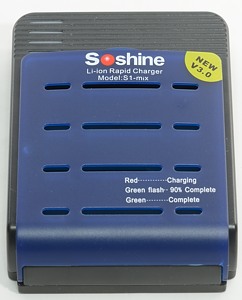

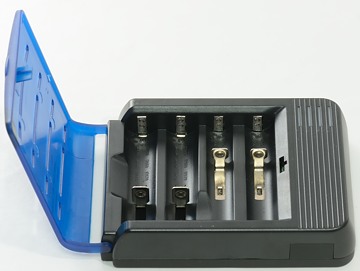
This is the mix version of the S1 charger, I have reviewed the max version in another review. Soshine does also makes other chargers and I have reviewed some before (S7,S2).
The idea being the mix charger is that it has bays in two different lengths with different charge current, making it possible to charge a broad selection of LiIon battery sizes.
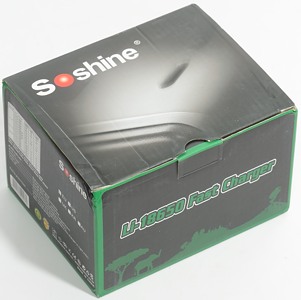
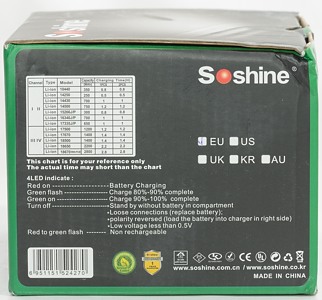
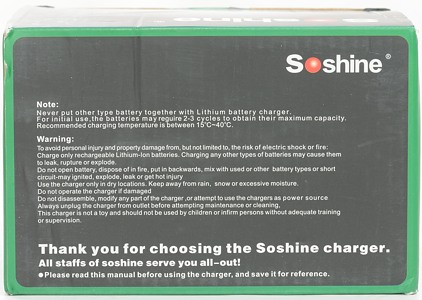
The charger arrives in a cardboard box, that also works as manual.

Actual contents is the charger, a universal power supply (100-240 VAC 50/60Hz), including a EU plug adapter and a car power adapter.
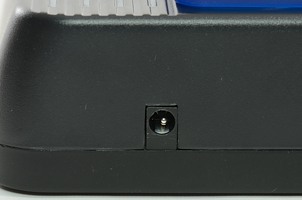
Power input on the charger is a small DC connector, it need 12 volt 1.8A according to the label on the bottom of the charger.
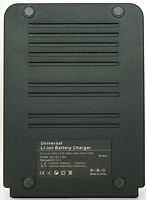
The bottom has the label and a lot of slots for air. The slots are not going to help much because the top of the charger does not have matching vents and when stuffed with batteries there is very little space around them (I did not notice any excess heating during tests).
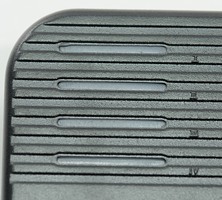
The charger has 4 leds one for each channel, that can be either red or green.
- Red: Charging.
- Flashing green: nearly done charging.
- Green: Battery fully charged.
- Off: No battery, very low battery or reverse battery.
- Flashing red/green: Non rechargeable.

The two different slots. The short slots cannot slide fully back without some help.
Maximum length on the short slots is about 47 mm, i.e. they do not fit 14500.
Maximum length on the long slots is above 70mm, minimum is about 48 mm.
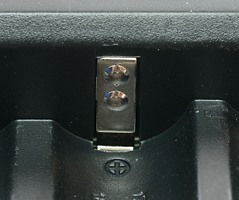

The connections are slightly raised, i.e. it can charge flat top batteries. The slider slides smooth on the long slots, but as I wrote above the short slots has a problem with the last few mm.

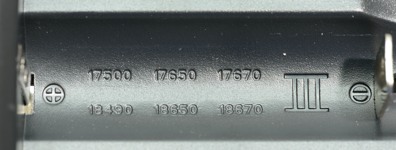
Each slot is clearly marked with polarity and supported battery sizes.
The short slots list some battery sizes that are to small for the charge current!


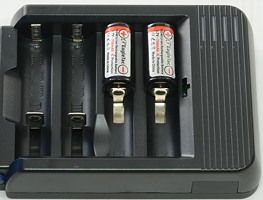
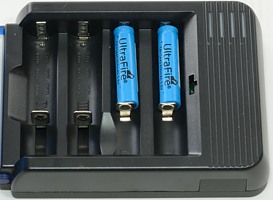
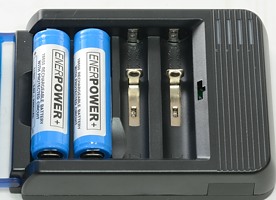
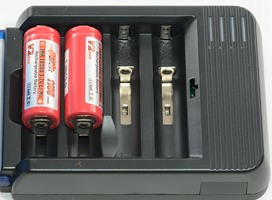
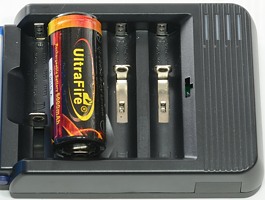
The charger is not rated for 26650 batteries, but it is possible to put one in the charger and charge it.
The charger can handle over 70 mm long batteries, including flat top cells.
But 14500 cannot be charged in it, except at 1A and that is too high a current.
Measurements
- Discharge battery with 3mA when power is disconnected.
- Discharge battery with 0.2mA when power is connected.
- Charge will restart if battery voltage drops to 3.9 volt.
- The charge will restart when a battery is inserted or power is cycled.
- Will flash green/red and charge with up to 5mA below 1.6 bolt
- Between 1.6 volt and 3.25 volt it will show steady red light and charge with 0.46A for long slots and 0.18A for short slots.
- Above 3.25 volt it will use CC/CV charge algorithm, see below.
- Charge termination current is about 100mA for both size slots.
- The channels are independent and there is small variations between them.
.png)
Charging a 3400mAh battery takes about 4 hours. At 200 minutes (Where the green current line gets thick), the charger starts flashing green, i.e. signally that the charger is nearly finished. This feature is very useful when short on time, as can be seen on the blue mAh curve there is very little capacity gain during until the charge is finished. I.e. removing the battery when the green led flashes will give nearly full capacity, and save some charging time.
.png)
The other slot works the same way.
.png)
Charging both long slots at the same time, does not reduce the charge current, i.e. it will charge two batteries just as fast as one battery.
.png)
A 3100mAh battery is slightly faster to charge.
.png)
Going down to 2600mAh reduces the charge time slightly.
.png)
I was very curious about the charge current in the short slots, the specifications changed between 300mA and 500mA depending on where I read it (Box:500mA, charger:300mA). A 300mA charge current would be fine for 10440, but 500mA is too high.
As can be seen on the curve the charger uses 500mA.
The termination current is the same as the long slots, i.e. around 100mA, this is too high for smaller batteries and will prevent them from being fully charged.
.png)
The second short slot is the same. This battery was below 3.25 volt when starting to charge and the charger uses a lower current, until 3.25 volt.
Testing the mains transformer with 2500 volt and 5000 volt between mains and low volt side, did not show any safety problems. The EU plug converter is a safety hazard, as they always are (Buying the charger from a EU source will probably get a real EU adapter).
Conclusion
The charger is not as universal as it is supposed to be. The short slots uses too high current and are too short for 14500 and the slider does not slide smoothly.
With the acceptable sizes the charger does a very good job with CC/CV charge, but with a few modifications it would have worked for more battery sizes. The missing support (or too high current using a long slot) for 14500 and too high current for 10440 does reduce the usability significantly for this charger.
Notes
All test was done at 110 VAC.
Here is an explanation on how I did the above charge curves: How do I test a charger






















.png)
.png)
.png)
.png)
.png)
.png)
.png)